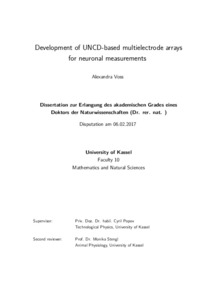| dc.date.accessioned | 2017-07-26T13:18:56Z | |
| dc.date.available | 2017-07-26T13:18:56Z | |
| dc.date.issued | 2017-07-26 | |
| dc.identifier.uri | urn:nbn:de:hebis:34-2017072653134 | |
| dc.identifier.uri | http://hdl.handle.net/123456789/2017072653134 | |
| dc.description.sponsorship | Zentrale Forschungsförderung (ZFF) of the University of Kassel, Deutsche Forschungsgemeinschaft (DFG) grant PO 789/3-1 | ger |
| dc.language.iso | eng | |
| dc.rights | Urheberrechtlich geschützt | |
| dc.rights.uri | https://rightsstatements.org/page/InC/1.0/ | |
| dc.subject | Ultrananocrystalline diamond | eng |
| dc.subject | Bio application | eng |
| dc.subject | Multielectrode array | eng |
| dc.subject | Microstructuring | eng |
| dc.subject | Surface modification | eng |
| dc.subject | Guided cell growth | eng |
| dc.subject | Transparent substrates | eng |
| dc.subject.ddc | 500 | |
| dc.title | Development of UNCD-based multielectrode arrays for neuronal measurements | eng |
| dc.type | Dissertation | |
| dcterms.abstract | The work in hand will show how some of diamond’s extraordinary features can be utilized in bio-applications especially for in vitro cultures of neuronal cells. Diamond has proven itself as an excellent material for bio-applications such as simple fluorescent microarrays over bioFET (field effect transistor) to bioMEMS (microelectro-mechanical systems). The reason does not only lie in its best known properties namely extreme hardness and high refractive index, but in its unique chemistry. As one of the modifications of carbon, composed of sp3-hybridized atoms only, there are no toxic components present. Diamond is chemically inert preventing any fouling, degradation or other unwanted surface reactions. Its broad electrochemical window is of advantage for any electrical measurement in aqueous solution especially cell culture media. All this leads to a high bio-compatibility. By modifying the surface chemistry interaction with bio-entities can be further improved and controlled. For investigation of neuronal activity and behavior it is not sufficient to look at single cells. Understanding network formation and complex processes like learning or the internal clock is possible only by looking at a great number of cells simultaneously over a long period of time. To fulfill this purpose multielectrode arrays (MEA) have been developed. But although these devices are around since the late 1970s still there is potential for improvement. In this work ultrananocrystalline diamond (UNCD) coatings will be applied to a passive MEA design in order to increase cell adhesion. This will reduce leakage currents and background signals stemming from surrounding cells. To accompany electrical measurements with fluorescence observation transparent substrates are required. Here the range of choice is limited by the high substate temperature necessary for the growth of artificial diamond layers. Also metal layers for contacting the cell electrically will have to grant uniform and homogenous UNCD growth. Additionally, those metal layers have to be shaped using microstructuring techniques such as optical lithography and lift-off. | eng |
| dcterms.accessRights | open access | |
| dcterms.creator | Voss, Alexandra | |
| dc.contributor.corporatename | Kassel, Universität Kassel, Fachbereich Mathematik und Naturwissenschaften, Institut für Physik, Technische Physik | |
| dc.contributor.referee | Popov, Cyril (Dr.) | |
| dc.contributor.referee | Stengl, Monika (Prof. Dr.) | |
| dc.subject.swd | Mikroelektrode | ger |
| dc.subject.swd | Array | ger |
| dc.subject.swd | Mirkromechanik | ger |
| dc.subject.swd | Oberflächenbehandlung | ger |
| dc.subject.swd | Modifizierung | ger |
| dc.subject.swd | Zellwachstum | ger |
| dc.subject.swd | Diamant | ger |
| dc.date.examination | 2017-02-06 | |

